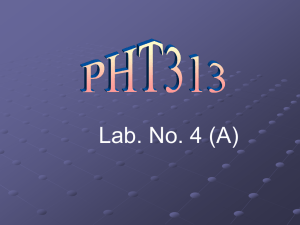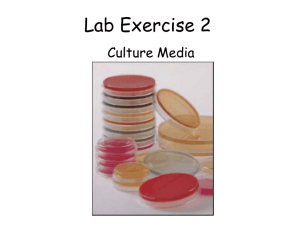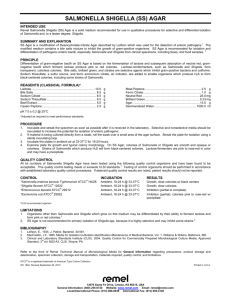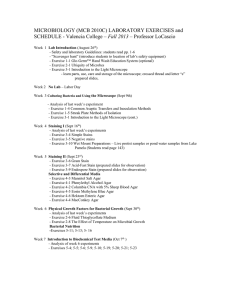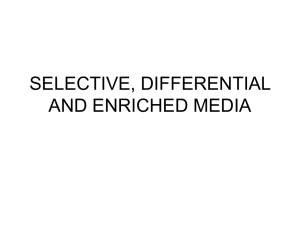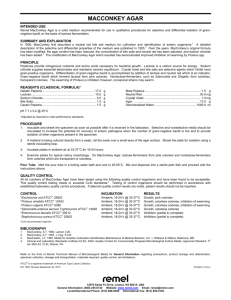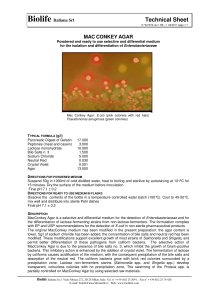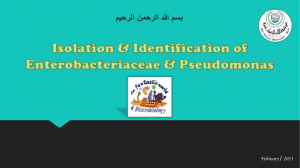Gram-negative rods - Home - KSU Faculty Member websites
advertisement
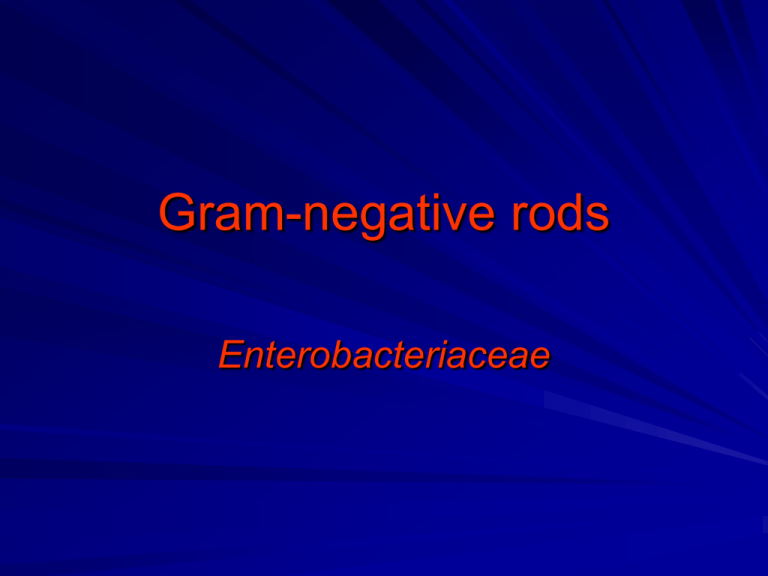
Gram-negative rods Enterobacteriaceae Bacteria Gram positive Cocci Bacilli Gram negative Cocci Rods Characters of Enterobacteriaceae All Enterobacteriaciae – – – – Gram-negative rods Ferment glucose with acid production Reduce nitrates into nitrites Oxidase negative Facultative anaerobic Motile except Shigella and Klebsiella Non-capsulated except Klebsiella Non-fastidious Grow on bile containing media (MacConkey agar) Enterobacteriaceae Some Enterobacteriaceae are true pathogens – – – – Salmonella spp. Shigella spp. Yersinia spp. Certain strains of E. coli (ETEC, EPEC, EIEC, EHEC) Most members of the Enterobacteriaceae are opportunistic or cause secondary infections of wounds, the urinary and respiratory tracts, and the circulatory system e.g. E. coli. Enterobacteriaceae divided into TWO main groups according to action on LACTOSE – Lactose Fermenters (LF) E. coli, Citrobacter, Klbesiella, Enterobacter – Lactose Non-Fermenters (LNF) Salmonella, Shigella, Proteus, Yersinia Identification of Enterobacteriaceae Gram stain – All Enterobacteriaceae are Gram-negative rods – Arranged in single Identification of Enterobacteriaceae Biochemical reactions Oxidase test – All members of Enterobacteriaceae are oxidase negative – Pseudomonas is oxidase positive O/F test – All members of Enterobacteriaceae are O+/F+ – Pseudomonas is O+/F- Nitrate reductase – All members of Enterobacteriaceae are nitrate reductase positive – Pseudomonas is nitrate reductase negative See & compare these tests under Pseudomonas Lab Classification of Enterobacteriaceae Enterobacteriaceae Lactose fermenters E. coli, Citrobacter, Klebsiella, Enterobacter Non-lactose fermenter Salmonell, Shigella Proteus, Yersinia There are several selective and differential media used to isolate distinguishes between LF & LNF The most important media are: MacConkey agar Eosin Methylene Blue (EMB) agar Salmonella Shigella (SS) agar In addition to Triple Sugar Iron (TSI) agar Differentiation between LF & NLF by Growth on MacConkey agar MacConkey agar is selective & differential medium for Enterobacteriaceae MacConkey Agar Contains Bile salts Crystal violet Inhibit growth of G+ve bacteria Cause of selectivity Lactose feremnters Pink colonies Lactose Cause of differential Neutral red pH indicator Acidic: Pink Lactose non feremnters colorless colonies Classification of Enterobacteriaceae according to lactose fermentation (growth on MacConkey Agar) Enterobacteriaceae Lactose Fermenters Acid Lactose Non-Fermenters No acid Neutral red Pink colonies Escherichia coli Klebsiella spp Enterobacter spp Citrobacter spp Colorless colonies Salmonella spp Schigella spp Proteus spp Yersinina spp Identification of Enterobacteriaceae Differentiation between LF & NLF by Growth on MacConkey agar Method: – MacConkey agar is inoculated with tested organism using streak plate technique – Incubate the plate in incubator at 37 C/24 hrs Results: – LF organism appears as pink colonies (e.g. E. coli) – NLF organism appears as colorless colonies (e.g. Shigella) Flame & Cool 2 1 3 4 5 Flame & Cool Flame & Cool Growth of Enterobacteriaceae on MacConkey agar Colorless colonies Uninoculated plate Lactose non feremters Salmonella, Shigella, Proteus Pink colonies Lactose feremters E. coli, Citrobacter Klebsiella, Enterobacter Reaction on Salmonella Shigella (SS) agar SS agar is a selective & differential medium used for isolation of Salmonella and Shigella The selective agents are bile salts, and brilliant green dye, which inhibit gram-positive organisms The medium contains only lactose as a differential agent and thus differentiates on the basis of lactose fermentation The formation of acid on fermentation of lactose causes the neutral red indicator to make pink colonies Non lactose fermenting organisms are colorless on the medium SS agar contains sodium thiosulfate and ferric ammonium citrate allows the differentiation of organisms that produce H2S – Lactose fermenters, such as E. coli, have colonies which are pink – Shigella appears transparent or amber – Salmonella appears transparent or amber with black centers due to H2S production Lactose Lactose fermenter Acid H2S + Ferric ammonium citrate Neutral red Pink colonies Ferrous sulfide Black precipitate Identification of Enterobacteriaceae Differentiation between LF & NLF by Growth on SS agar Method: – SS agar is inoculated with tested organism using streak plate technique – Incubate the plate in incubator at 37 C/24 hrs Flame & Cool 1 2 3 4 Flame & Cool 5 Flame & Cool Growth of Enterobacteriaceae on SS agar A .Klebsiella pneumoniae B .Escherichia coli C :Salmonella sp. D :Proteus mirabilis E :Ps. aeruginosa . Both are lactose fermenters Both Salmonella sp. & Proteus product H2S Pseudomonas colonies are nearly colorless Growth of Enterobacteriaceae on EMB agar Coli-type colonies are very dark, almost black e.g. E. coli Reaction on Triple Sugar Iron (TSI) Agar TSI contains – Three different types of sugars Glucose (1 part) Lactose (10 part) Sucrose (10 part) – Phenol red (acidic: Yellow) TSI dispensed in tubes with equal butt & slant Principle – To determine the ability of an organism to attack a specific carbohydrate incorporated into a basal growth medium, with or without the production of gas, along with the determination of possible hydrogen sulphide production. Reaction on TSI Method: – Inoculate TSI medium with an organism by inoculating needle by stabbing the butt and streaking the slant – Incubate at 37°C for 24 hours Reaction on TSI Butt color Slant color Yellow Red Yellow Red Yellow Yellow Red Red H2 S Result s Result Negative Positive black in butt Negative Negative Example A/Alk/(Glucose fermented) LNF e.g. Shigella A/Alk/+ (Glucose fermented with H2S) LNF e.g. Salmonella & Proteus A/A/(three sugars are fermented) LF e.g. E. coli, Klebsiella, Enterobacter Alk/Alk/(No action on sugars) Non fermenter e.g. Pseudomonas Practicle Work Gram stain Oxidase test O/F test Nitrate reductase test Growth on MacConkey’s agar Growth on EMB agar Growth on SS agar Reaction on TSI
